RUG Lands is arguably the longest-standing version of Lands. Popular during the early years of the 2010s, before the Stage-Depths combo was available, RUG employs a far more toolbox approach to the prison element, using powerful cards such as Intuition to tutor up answers to problems or Life from the Loam itself. Intuition also enables us to play an artifact package composed of cards like Ensnaring Bridge, Engineered Explosives and Zuran Orb alongside Academy Ruins to put the screws into the opponent. By doing so, it seeks to lock opposing decks out before providing a kill, trading speed for versatility when compared to its younger RG brother.
As Legacy grew faster and faster with each passing year, the RUG version of Lands generally fell out of favour, as mere prison elements weren’t enough to win in Legacy anymore, especially when compared with the explosiveness provided by Gamble out of RG lists. However, with the recent printing of such cards as Uro, Titan of Nature’s Wrath and Oko, Thief of Crowns, it has enjoyed a resurgence, as the blue splash for these cards is definitely a great boon to our deck. This flavour is very similar to the BUG version, thought it generally relies on Engineered Explosives recursion and Punishing Fire (instead of Abrupt Decay) to keep the board clean. It often uses Gamble and Uro, Titan of Nature’s Wrath in the maindeck, and Oko, Thief of Crowns and Pyroblast out of the sideboard. Quite possibly the most flexible among Lands builds, it however trades raw power and speed in order to have access to the answers it enjoys.
Card choices for the maindeck mainly range among the aforementioned cards that are playable in the RUG colour wedge. These are mainly (but not limited to):
Uro, Titan of Nature’s Wrath
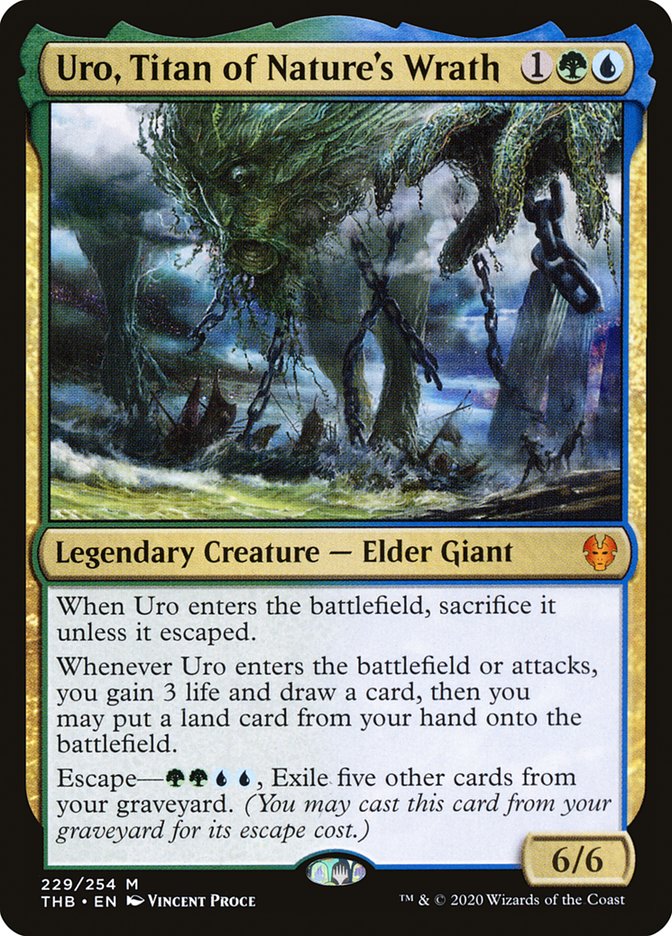
At this point it pretty much goes without saying, but Uro is a great auxiliary engine that also stonewalls most commonly played threats, is recurrable and can be dredged/escaped easily thanks to Loam. Its ability to ensure we stabilize thanks to its lifegain is especially important, as this flavour is generally slightly slower than most of the other versions of Lands. While being excellent at what it does, RUG relies on it less, preferring to play 1-2 copies in comparison to UG (see below) which plays the full four, as we still have access to tutors like Gamble.
Verdict: Play 1-2
Gamble
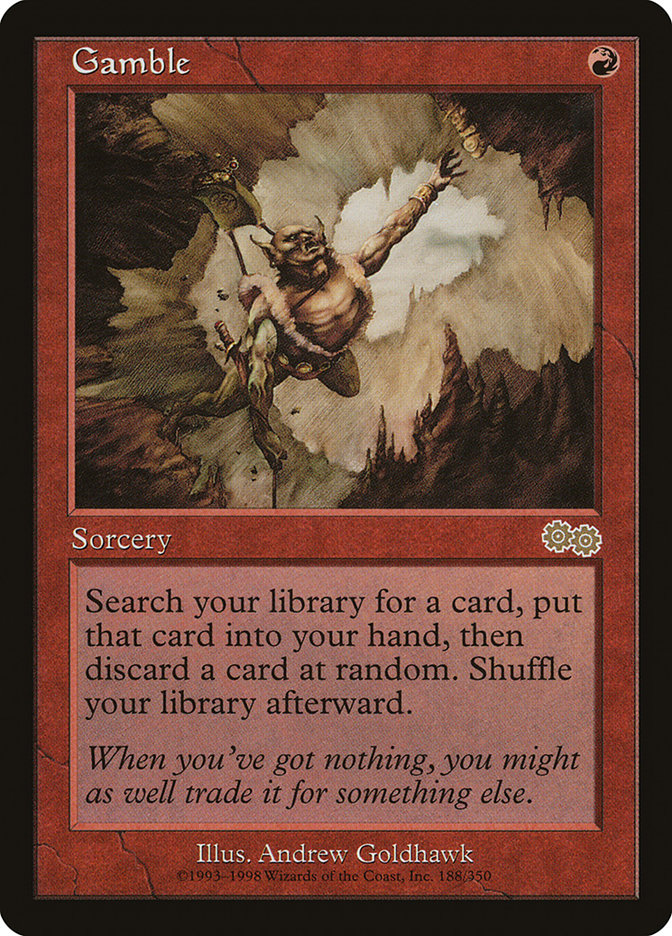
Here we can see the one of the great advantages of playing red alongside blue and green. Whereas BUG really only has access to Entomb, having access to Gamble allows tutoring of a wider range of cards, such as Exploration or, in games 2 and 3, Sphere of of Resistance. Being a sorcery however is not without downside, as it turns on opposing Force of Negation and is harder to play reasonably in the face of discard, especially if on the draw. However, RUG still opts to play a couple copies, much like in straight RG.
Verdict: Play 1-3
Engineered Explosives
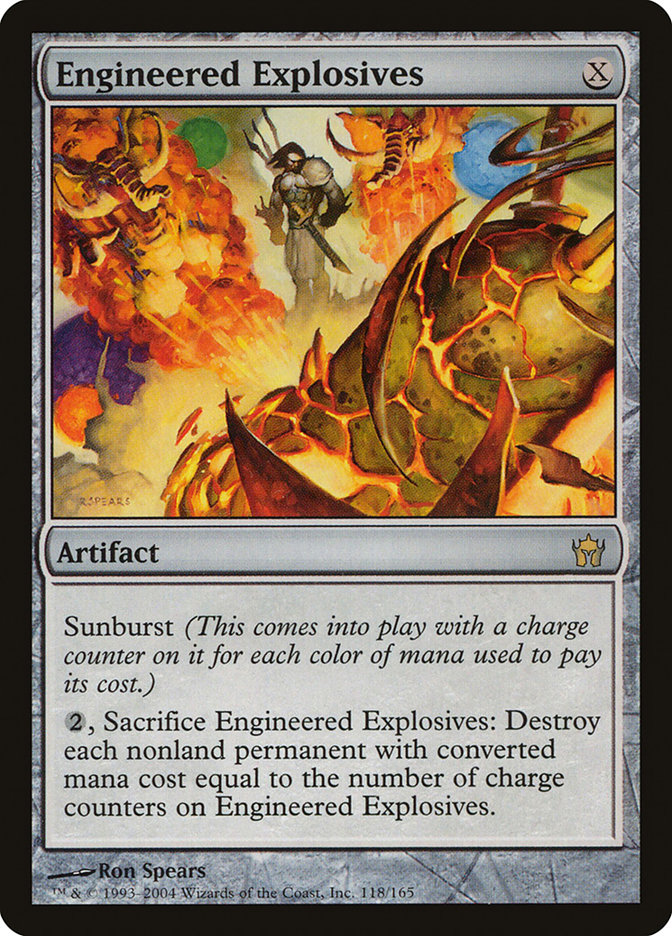
The first half of RUG’s non-land based board control, Explosives gives RUG a flexible out to what would otherwise be hard to answer permanents in game 1. Back to Basics, Counterbalance, Rest in Peace and creatures with high toughness such as Tarmogoyf and Knight of the Reliquary are much easier to deal with when having access to Engineered Explosives in addition to Punishing Fire. Effectively functioning as a one sided board wipe when used with care, it has the downside of being slower and more fragile as an answer to Dreadhorde Arcanist in comparison to Abrupt Decay. Still, the potential to destroy permanents with any mana cost less than or equal to five make it worth of consideration (our deck can produce all 5 colors with the help of Mox Diamond), and it also handily deals with creature tokens.
Engineered Explosives becomes even more powerful when played in tandem with Academy Ruins, as it is perfectly capable of keeping the board under control and answering most problematic permanents, all the while being easy to find with Life from the Loam.
As a small note, it’s worth discussing briefly how starburst interacts with taxing effects such as that of Thalia, Guardian of Thraben, Trinisphere or even our own Sphere of Resistance. As an example, assume the opponent has a Thalia out that we want to destroy. We can simply play Explosives for one and declare such. The Thalia tax then is added, to which we can pay another coloured mana; thus bringing the starburst counter to 2, while effectively circumventing Thalia’s tax ability. Keep this in mind when declaring X for Explosives upon casting it.
Verdict: Play 1-2
Punishing Fire

Punishing Fire, while previously an all-star, has lost quite a bit of equity with the exponential increase in power creep 2019 and 2020 brought to Magic. It cannot deal with many problematic permanents, foremost among these being Dreadhorde Arcanist, and its falling out of favour was one of the prime reasons to drop red. However, it still shines in several matchups, from Elves to Death and Taxes to Maverick. Generally played alongside Engineered Explosives in RUG as both a win condition and pinpoint removal, it has far more difficulty in dealing with creatures (thanks to its 2 damage) when compared to Abrupt Decay, all the more while being rather mana intensive and soft to Force of Negation. It still mops up creature decks quite nicely, even though nowadays Lands has somewhat moved away from it.
Verdict: Play 1-2
Academy Ruins
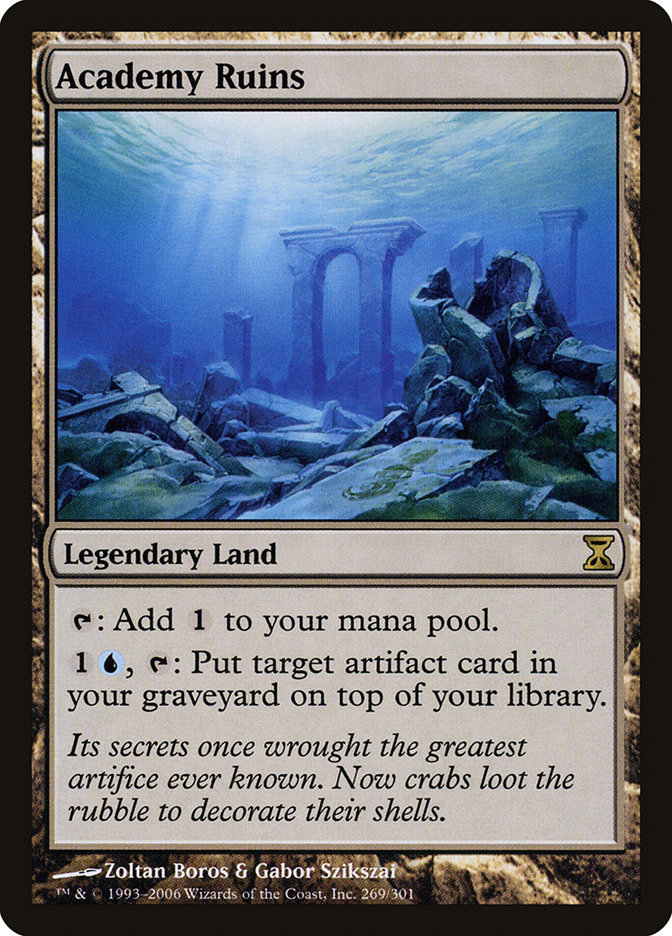
Generally played in slower metas, it combos with Engineered Explosives to keep the board clean indefinitely. It is great in slower creature matchups but is often too slow in faster metas, and actively bad against combo (though one can occasionally tag mana rocks or Grindstones). Still, quite good and should definitely be in your collection/on your radar, should you choose to play the blue splash, as it opens up other interesting maindeck inclusions such as Ensnaring Bridge and Zuran Orb. Although it comes up rarely, Academy Ruins and Engineered Explosives can be effectively used to deck opponents. While not as viable today as in the past, it still is a possible win condition should the need arise. Ruins keeps putting an artifact on the top of our deck so that we can never draw out, while also slowly grinding out the opponent’s threats.
Verdict: Play 1
Tolaria West

Another excellent card in our roster, Tolaria West shines in control-heavy metas, as it an uncounterable, recurrable tutor for an overwhelming majority of our deck. It is Dark Depths if we have Thespian’s Stage, Wasteland if we have Life from the Loam, Grove of the Burnwillows if we have Punishing Fire, and even Field of the Dead to start making Zombies. Getting Engineered Explosives is merely the icing on top. Sadly, the 3 mana cost of transmute can be quite clunky, and hence is another dead card in faster matchups, but an absolute all star in slower ones. Meta dependent, so 0 copies is of course fine, but when it’s good, a live Tolaria West is game-winning.
Verdict: Play 0-2
Intuition
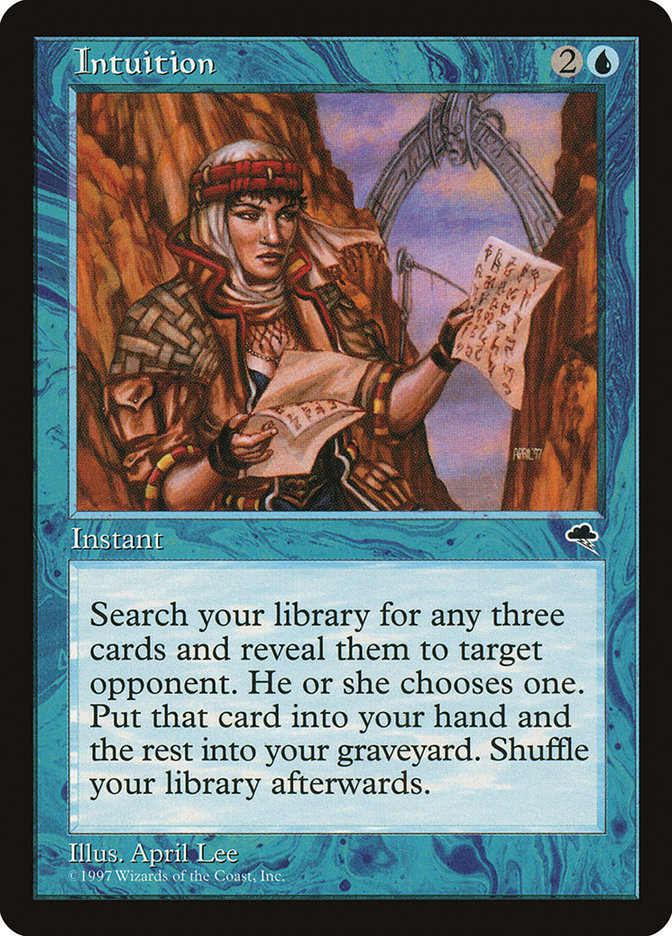
A blast from the past, Intuition used to be a Legacy staple, seeing play in several different decks from Miracles to Lands. Putting cards into the graveyard is quite fine for our deck, as it employs so many ways to get them back, however it was eventually supplanted by Gamble as the speed of Legacy increased. Still a powerhouse, its days as a staple are setting. Once again, it is another card that shines in slower metas, and as such should be kept in mind, as it gives a lot of flexibility. Getting both halves of the Depths Combo + Loam, Academy Ruins + Engineered Explosives and Loam, or just simply 3 Explorations are all potential applications, and myriad of possible decisions it enables make it very powerful as a toolbox choice.
Verdict: Play 0-2
Oko, Thief of Crowns

Easily one of the best planeswalkers ever to see print, it is playable in our deck and therefore should definitely be considered somewhere in the 75. Playing it in the maindeck is never wrong, though Uro, Titan of Nature’s Wrath is more synergistic with Lands’ gameplan, so relegating it to the sideboard is fine as you see fit, to bring in as a non graveyard win condition. In regards to its role, it helps deal with problematic permanents as well as allowing us to stabilize via creature creation or by simply activating food tokens to gain life. As already mentioned, it plays extremely well with Sylvan Library, and is great for board control when played in conjunction with Engineered Explosives or Punishing Fire. See the section on BUG Lands for a more exhaustive examination of Oko’s abilities.
Verdict: Play 0-3 copies among the maindeck or sideboard.
Sideboard:
Just as in the BUG and UG variants, we have several available options to us in UG colours, with the added option of Pyroblast from red. These are of course in addition to the usual sideboard mainstays such as Sphere of Resistance and Krosan Grip/Force of Vigor.
Pyroblast
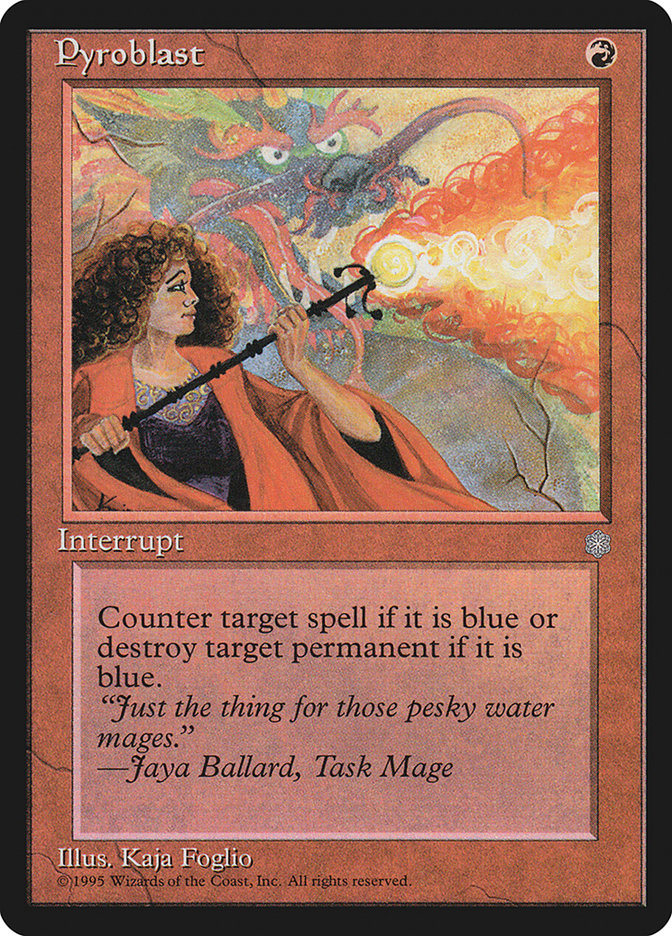
Arguably the greatest reason to play the red splash currently, as it answers so many cards (Show and Tell, True Name Nemesis, Oko, Thief of Crowns, Jace, the Mind Sculptor, Coun- terbalance and Back to Basics) as well as protects key spells against Force of Will (or Loam against Force of Negation). The card is a house in most matchups, as the format is inherently blue. Pyroblast is thus is an excellent reason to play red. Usually played as a mix between itself and its cousin Red Elemental Blast, both are great choices as sideboard cards. Usually played as a 1 or 2 of.
Mindbreak Trap
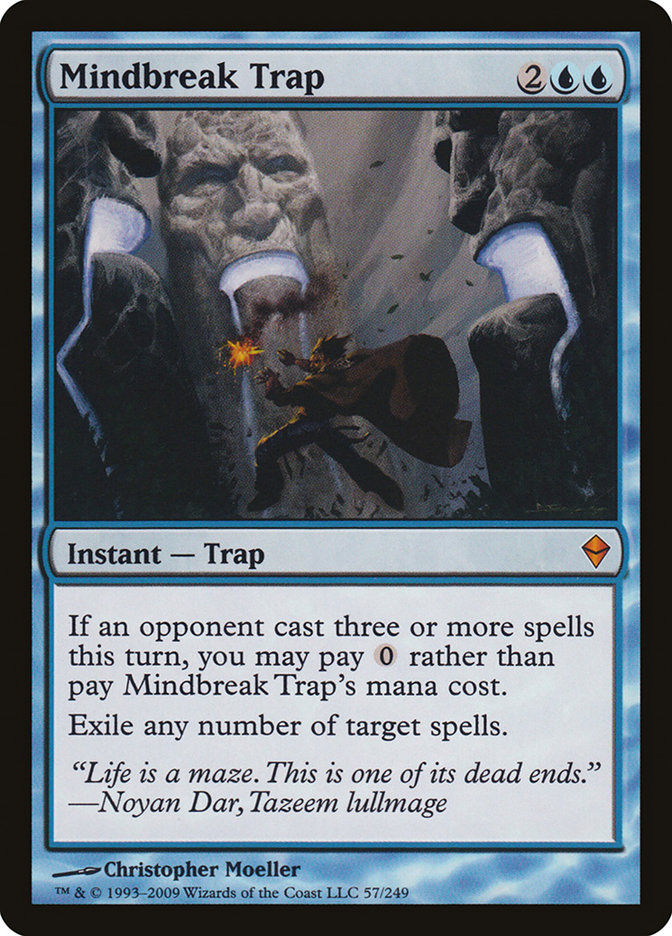
A relatively new addition to Lands sideboards, the card is an obvious choice as a hedge against combo decks with Lands moving towards the blue splash across so many variants. Especially during the Companion & Breach metas it arose as an answer to the turn 1 combo decks like Gyruda and Zirda that started seeing play. Trap serves as a means of not immediately losing when being on the draw. The card is very powerful, as it gets around uncounterability by means of its exile clause, making such cards as Veil of Summer and Cavern of Souls useless in the face of it. A solid all around choice for combo matchups, it is usually played alongside more classic choices such as Sphere of Resistance as an extra means of stopping combo decks in their tracks. Notably, the 3 spell criteria to reduce its mana cost is very easy to meet against Combo decks, and though it can be played around, decks like Reanimator and ANT/TES often play multiple spells a turn (Land-Dark Ritual-Entomb-Exhume being an example of this). Pilot dependent, but playing at least 2 copies is reasonable in combo heavy metas, if not more.
Chalice of the Void

Another legacy staple, Lands has often shied away from such cards, as Chalice on one can be very painful for our deck (we play several one mana spells such as Exploration, Crop Rotation and Gamble). However its strength in certain matchups cannot be understated, especially in matchups where we board out Crop Rotations, as it is a clean answer to Dreadhorde Arcanist and can be very painful for Delver decks to circumvent. Generally played as a fifth copy of a Sphere effect (a Lands deck typically wants four to five such effects) it is generally brought in against all combo decks, where it is strongest against Reanimator and ANT/TES, but weaker against Show and Tell and rather bad vs Turbo Depths and Painter. Usually played anywhere from zero to 2 copies.
Hydroblast

Hydroblast (and Blue Elemental Blast), while not as powerful as their red cousins, are still good choices in certain metas. Given how much Delver decks rely on Dreadhorde Arcanist, it is a solid card as it answers the only card we really have difficulty with from the quintessential Tempo deck in legacy. In addition, given the appearance of Snowko decks employing such cards as Blood Moon and From the Ashes, it is a perfectly fine choice in certain metas, albeit somewhat narrow. Another card to keep in mind, it sometimes makes the sideboard cut, it sometimes doesn’t. Play 0-1 copies.
This generally sums it up. All the other cards typically played as sideboard choices have already been mentioned in the ”Core Cards” section.
Sample RUG Deck and Hands
Based on the above discussion of card choices, we can bring it all together to present the following sample decklist:



Sideboard
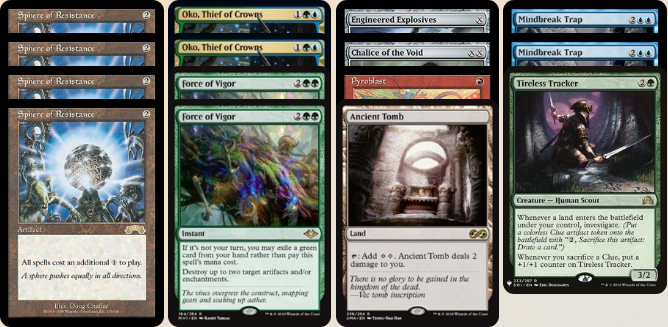
Although this list eschews the use of Intuition, we do see the strong toolbox of aspect of RUG Lands shining through. This deck makes excellent use of Gamble, above even what RG Lands can do. In addition to the usual Loam and lands targets, here we can Gamble for Uro, for Engineered Explosives, or for Academy Ruins. We also run fewer Dark Depths and more Field of the Dead because of the latter’s synergy with Uro. The sideboard features Oko and Tracker as non-graveyard based threats, but also includes Ancient Tomb. While the presence of Tomb in a sideboard is a matter of some debate, here it is brought in with Sphere and Chalice to increase our ability to set up a turn one lock piece against combo.
Now let’s turn to some sample hands.
Hand N°1

This first hand is on the upper levels in terms of power. We have a turn one Sylvan Library, followed by a turn two Uro, and then the natural combo in hand. A definite keep, and playing out the fetchland first and then Mox Diamond, pitching Ruins followed by Sylvan Library is the correct sequence here.
Hand N°2

Another solid hand, as we have both acceleration (Exploration), our premier engine (Life from the Loam), Wasteland to go with it, and a means of removing problematic permanents (Engineered Explosives). Gamble simply is the icing on the cake. An excellent opener.
Hand N°3

This hand is very slow. While possibly keepable in slower matchups, we are really reliant on the resolution of Sylvan Library or Gamble. Naturally, one can expect at least one of the two to resolve. Nonetheless, this hand could easily be put on the back foot in faster matchups. Lets take a mulligan, as there are likely better sixes.
Mulligan N°1

This hand is excellent. We have Loam and acceleration (Mox Diamond) and a followup play in Uro. Punishing Fire rounds out this hand nicely, and indeed makes it difficult to know what to put back. Ideally, here we want to put back either Tabernacle, Karakas or Punishing Fire. I personally would put back Punishing Fire, as Karakas gives you an out to SnS/Reanimator, Tabernacle is fuel for Mox Diamond, (we already have psuedo removal with Uro) and Punishing Fire is rather mana intensive, as well as not a singleton (when compared to Karakas or Tabernacle). Plus, putting back a land makes this hand actively worse with Mox Diamond being present, and does not let us leverage Loam as much as one could potentially do.
This concludes the RUG Lands section of our primer. RUG is a strong choice, though lately not as popular. It showcases all the most Lands-y parts of Lands while incorporating tools that give it the capacity to outgrind almost any opponent. The price it pays for this is a slower speed and a vulnerability to graveyard hate, compared to BUG or Jund. That said, for those in known metas or who simply want to play with some delicious toolboxes and synergies, RUG can be the perfect choice.